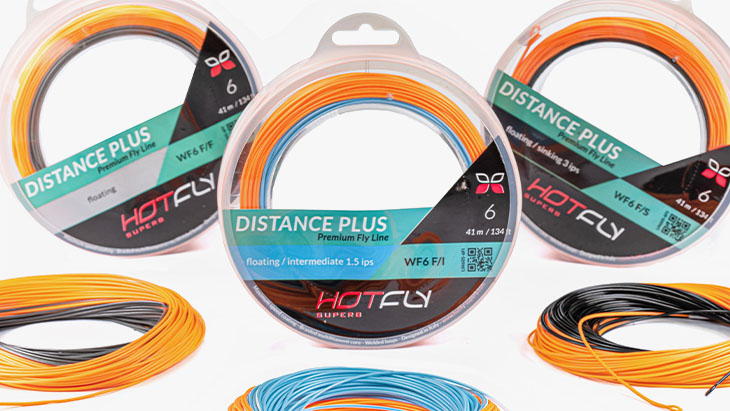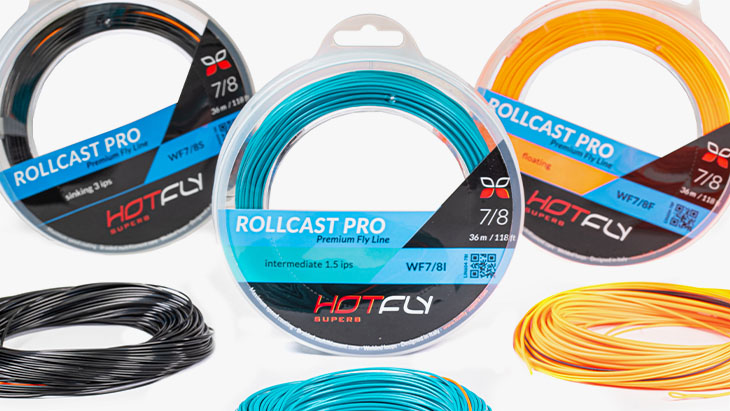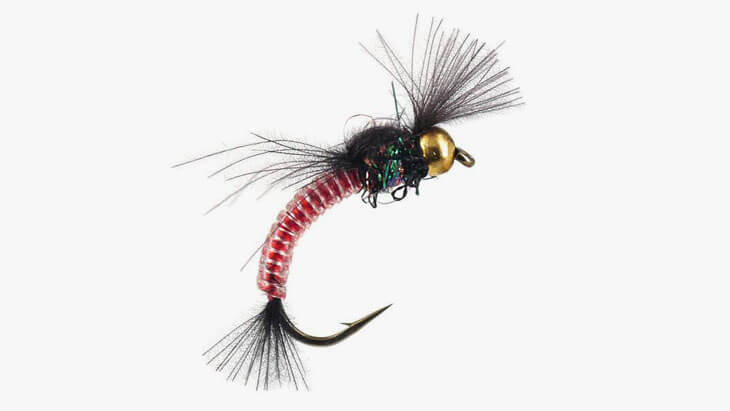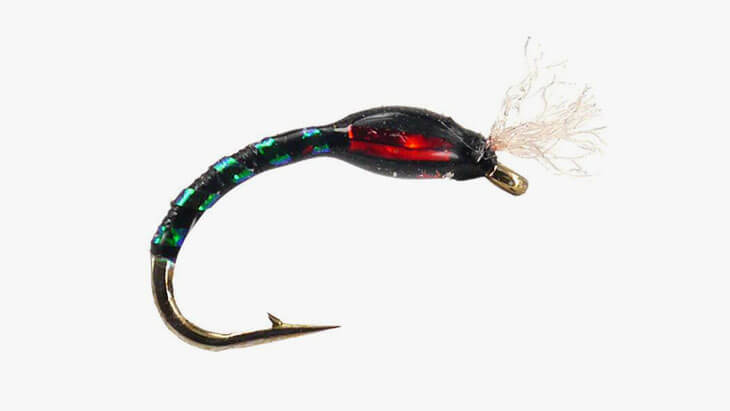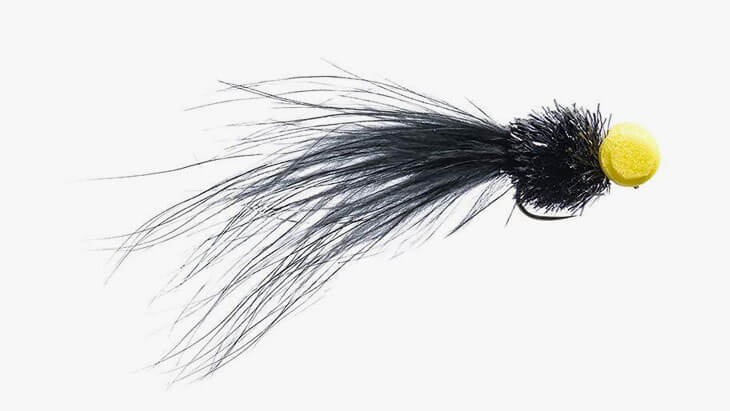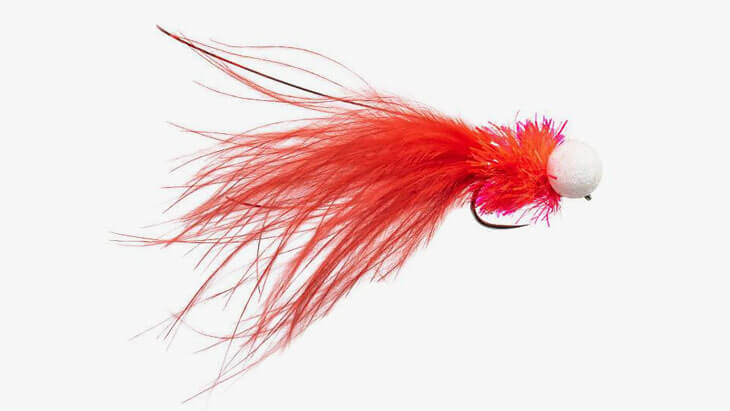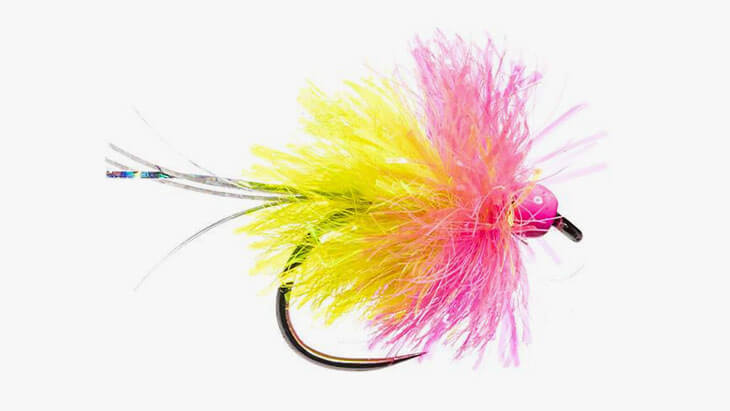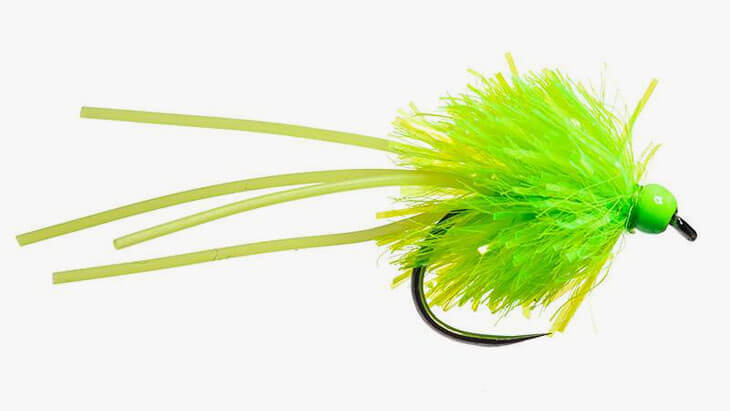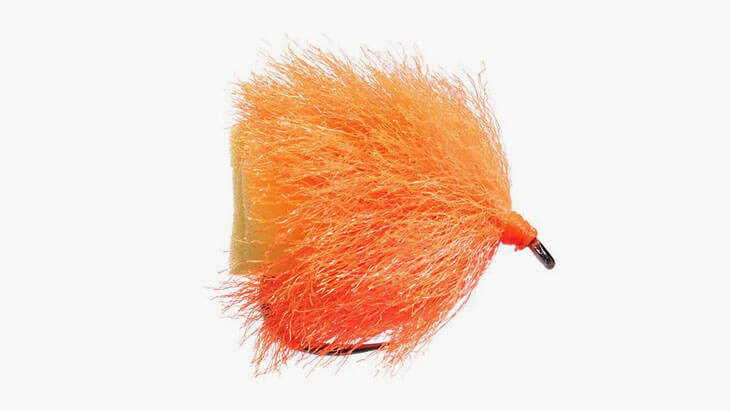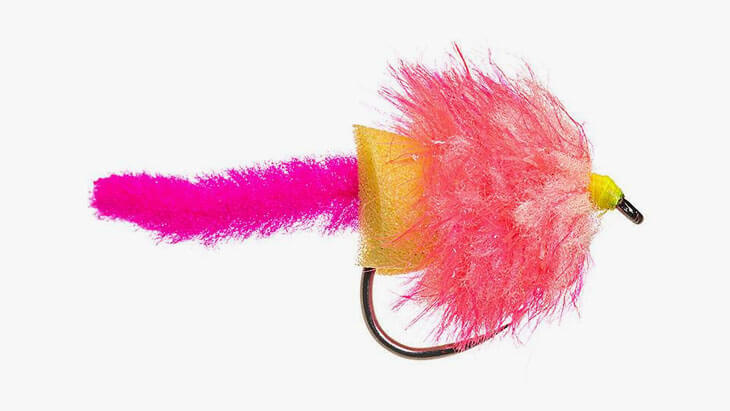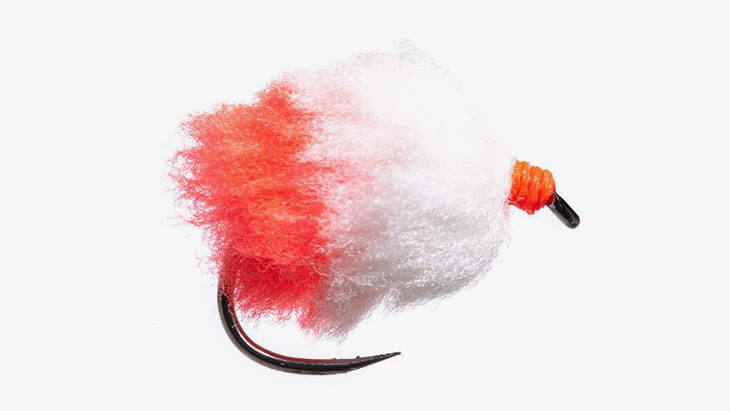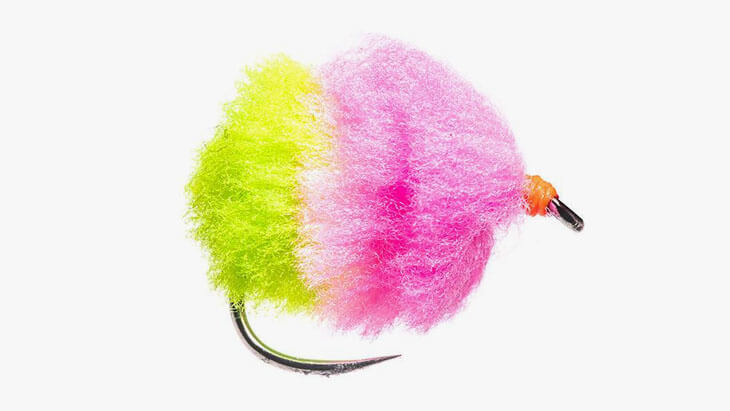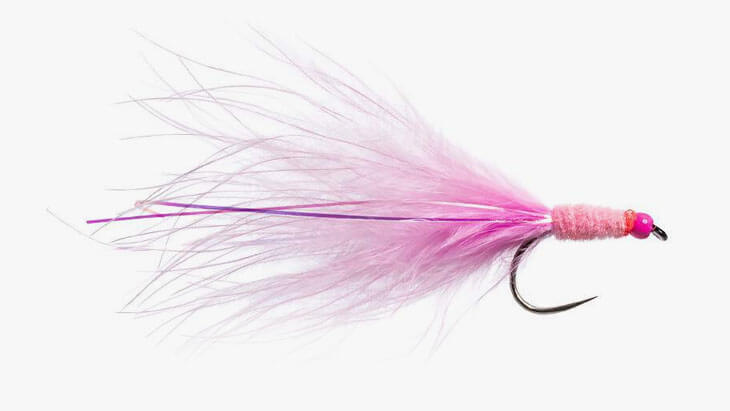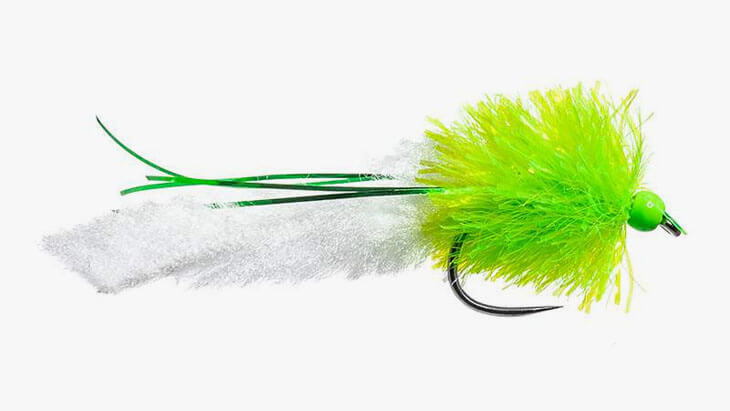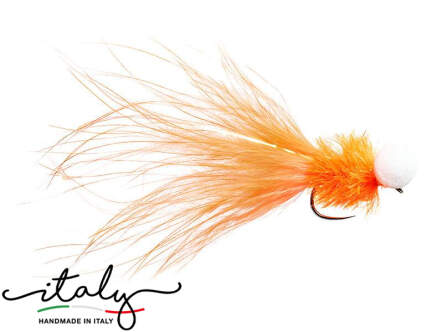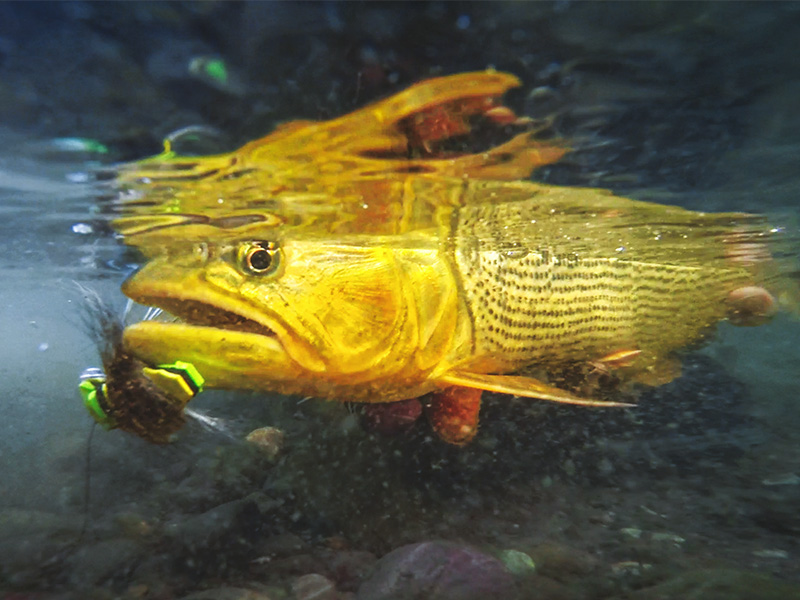DISCOVER THE EQUIPMENT, THE TECHNIQUES AND THE CATCHIEST FLIES OF THE PROS FOR FLY FISHING IN STILLWATER!
CONTENT:
- WHAT ARE THE ADVANTAGES OF FLY FISHING IN LAKES AND PONDS?
- WHAT DO I NEED TO BE SUCCESSFUL WITH A FLY IN STILLWATER?
- WHAT DOES THE RIGHT FLY ROD FOR STILLWATER FLY FISHING LOOK LIKE?
- WHAT DO I NEED TO CONSIDER WHEN BUYING A FLY REEL?
- WHICH FLY LINES ARE PARTICULARLY SUITABLE FOR FLY FISHING IN LAKES AND PONDS?
- ARRIVING AT THE WATER - WHAT IS THE BEST WAY TO START?
- HOW DO I CONSISTENTLY GET MY FLY TO THE RIGHT DISTANCE?
- THE FROLLER OR FROLL CAST
- SYSTEMATIC FISHING MEANS CATCHING MORE
- RETRIEVE AND HOOK SET
- WHICH FLY PATTERNS CATCH IN STILLWATER?
- WHICH RIGS FOR FLY FISHING IN STILLWATER?
Fly fishing in still waters is an integral part of the fishing culture in the British Isles. There, fly fishing in the so-called lochs and reservoirs, both from the boat and from the shore, has a long tradition and still enjoys great popularity today. Since fly fishing on stillwater in Great Britain is also practised in competitions, the development of new products and the refinement of the techniques used are also carried out in a correspondingly professional and innovative manner. On the European mainland, instead, fly fishing in lakes and ponds was rather a marginal phenomenon for a long time. In recent years, however, it has experienced an enormous upsurge, and quite rightly so. There are a number of good reasons for targeting fish with flies even in stillwater. It is irrelevant whether these are natural lakes, dams and reservoirs, or commercial fishing ponds. Fly fishing can be practised very well and, above all, very successfully on all these types of water.
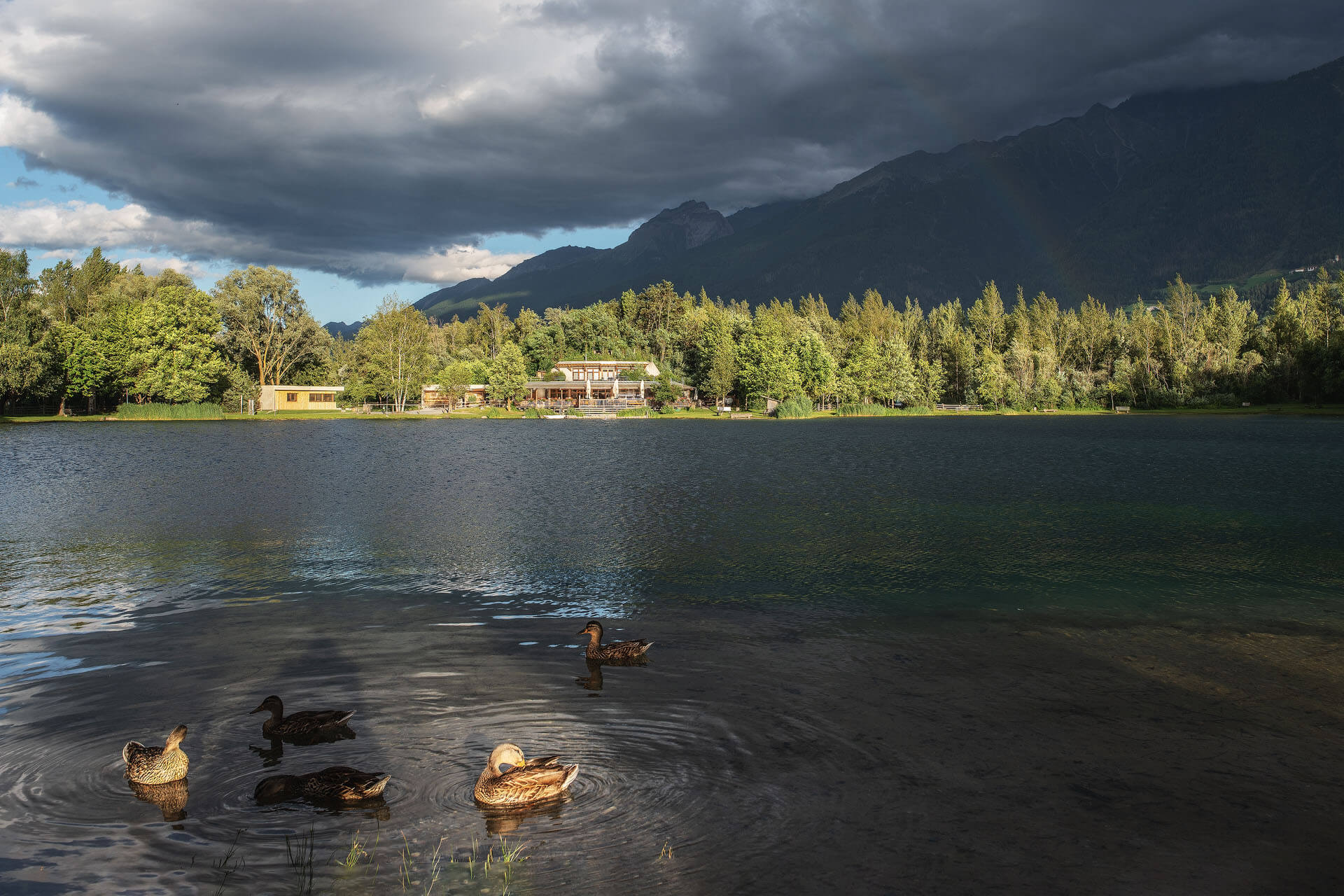
1. WHAT ARE THE ADVANTAGES OF FLY FISHING IN LAKES AND PONDS?
Not every enthusiastic fly fisherman has a mountain stream with grayling and trout on his doorstep. Stillwaters are usually easier and quicker to reach for many anglers than the classic fly-fishing areas in and around the Alps. The aspect of accessibility also speaks in favour of stillwaters, because fishing permits are usually much cheaper on such waters than on exclusive salmonid beats. Stillwaters are often home to a wide range of different species of fish that are interesting for fishermen, so fishing on such waters can be much more varied and exciting. In addition, the many species of fish found in lakes and ponds mean that they are in season practically all year round and can be fished perennially. Fly fishing in stillwater is therefore a good way to extend your season and actively bridge the closed season in streams and rivers. And last but not least, fishing attractiveness and catching success also play a role in why fishing in stillwater can be very tempting from a fly-fishing perspective. In the case of commercially operated fishing ponds, the operator naturally has an interest in visitors or customers being successful at his managed waters. Of course, this is no guarantee of a catch, but the managed lakes and angling ponds usually have very good fish stocks, so that fishing success is usually not long in coming, even for beginners.
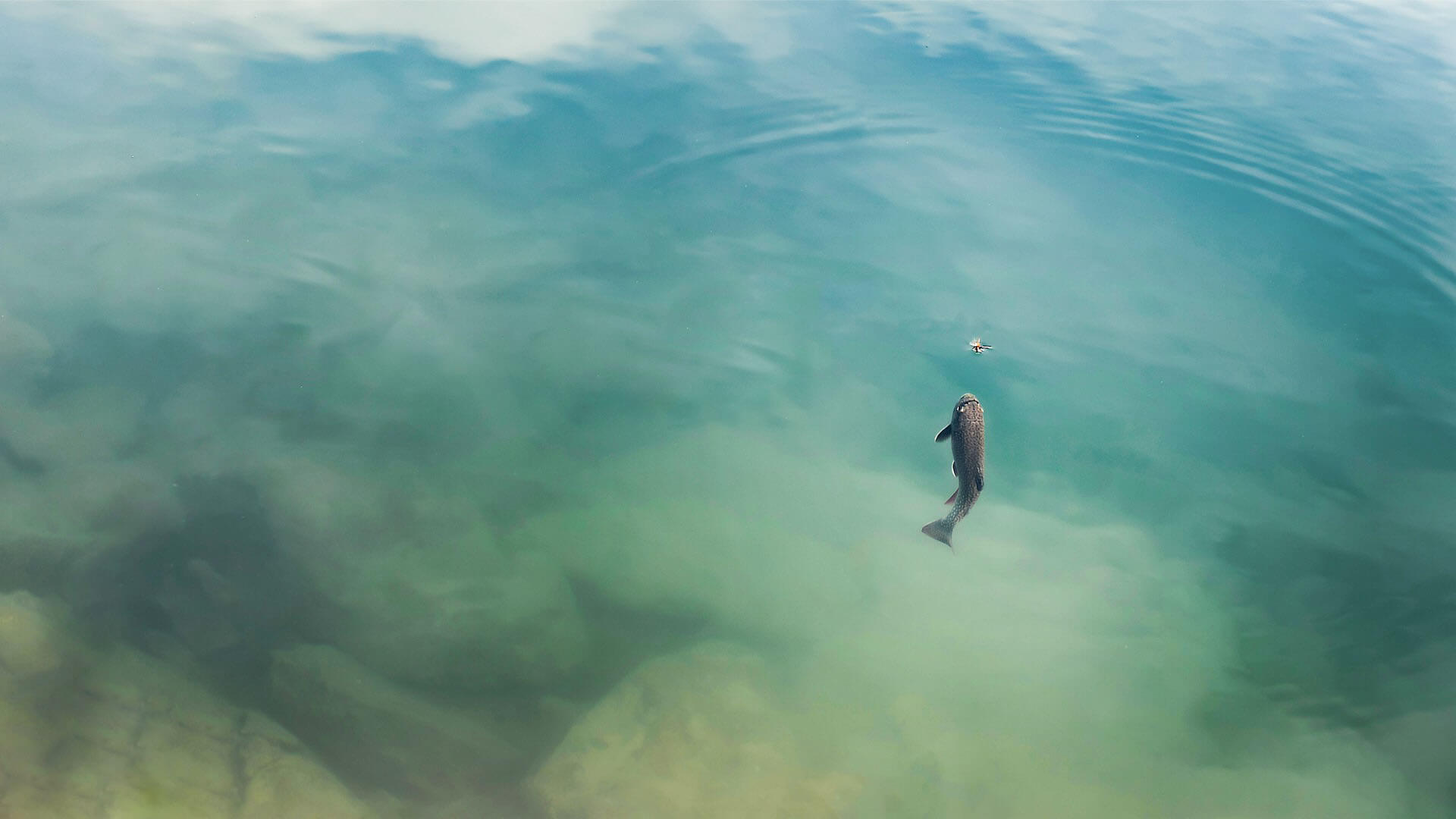
2. WHAT DO I NEED TO BE SUCCESSFUL WITH A FLY IN STILLWATER?
The good news: with your 9-foot-long all-round fly rod of line class #5 as well as some streamers, dry flies and nymphs you can start right away, especially at fishing ponds, and catch your first fish with it without any problems. Especially if you don't have a boat at your disposal, however, the distance at which you should present your fly to reach the active fish is often a challenge on larger waters. Often, the space for casting from the shore can also be limited at lakes and ponds. A fence, a hedge, a park bench or even a steep embankment on artificial quarry lakes are enough to prevent the classic overhead cast. In order to still be successful with the fly in such situations, special fly rods and fly lines have been developed so that you can present your fly even at long distances, cover a lot of water surface and also reach the fish. In addition, a special cast, the so-called Froller or Froll cast, helps you to cast far even when you only have a little space behind you. But before we introduce the Froller in detail, let's take a look at the optimal tackle set-up for fly fishing on lakes and ponds.
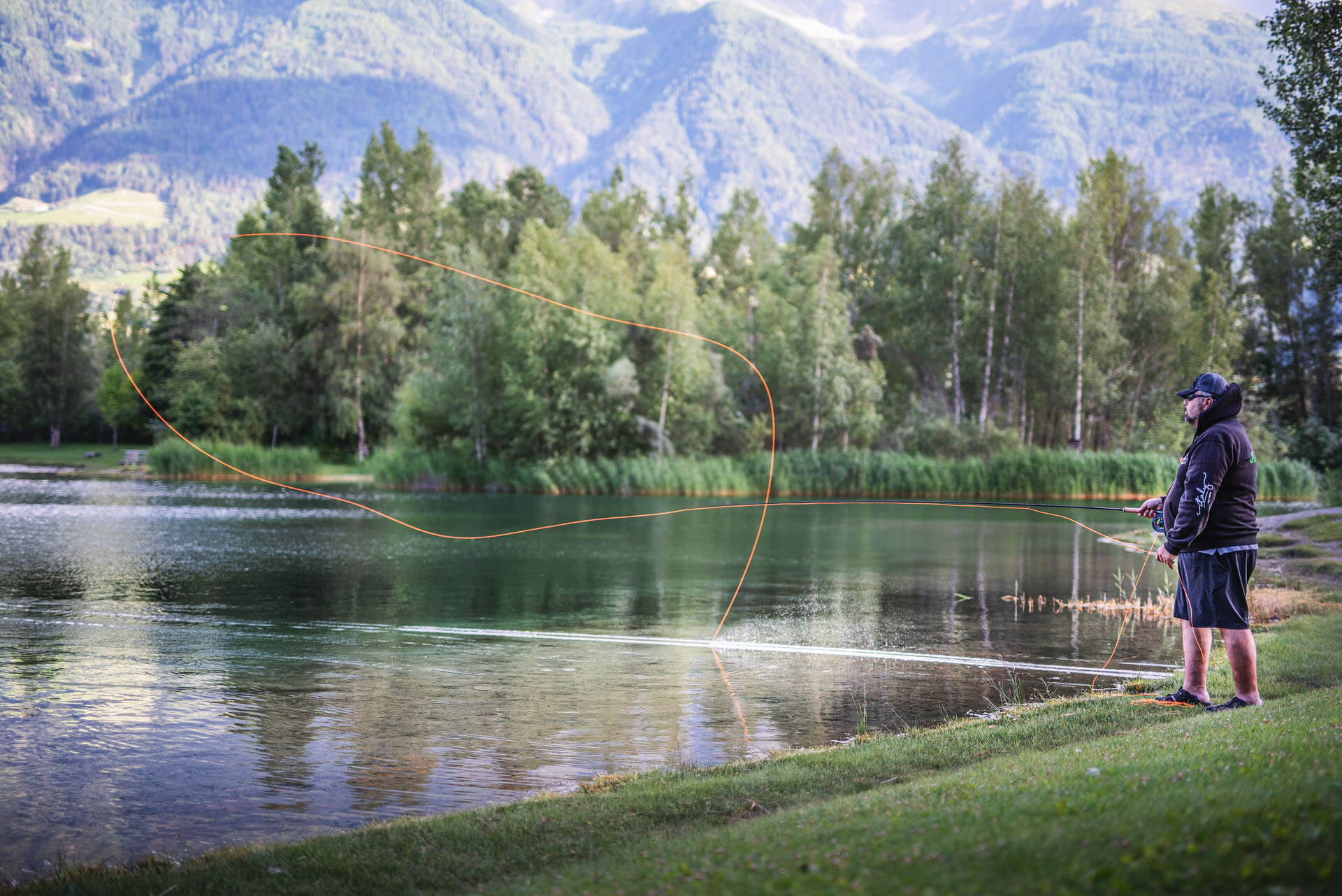
3. WHAT DOES THE RIGHT FLY ROD FOR STILLWATER FLY FISHING LOOK LIKE?
The ideal fly rod for stillwater fly fishing must allow you to do three things first and foremost: distance, distance and distance again. Regardless of whether you fish from the bank or from a boat, if you cast further, you will effectively fish more water surface and reach the active fish faster, easier and better. That's why we recommend a rod with a length of around 10 feet (305 cm), because the slightly longer lever makes it easier to handle larger amounts of line and cast more easily.
A fast and progressive action of the rod blank also makes casting at longer distances easier. In addition, the suitable fly rod should also have a strong backbone to be able to handle the special stillwater fly lines with the extra-long and thus correspondingly heavy belly well and easily without overloading the rod.
With the LAKEMASTER from Hotfly Superb we can recommend an excellent fly rod, which was developed in cooperation with experienced competition fishermen and specifically for use on stillwater. Not only does it have all the necessary features to fish successfully on lakes and ponds, but it is also first class in workmanship and all this at an absolutely fair price.
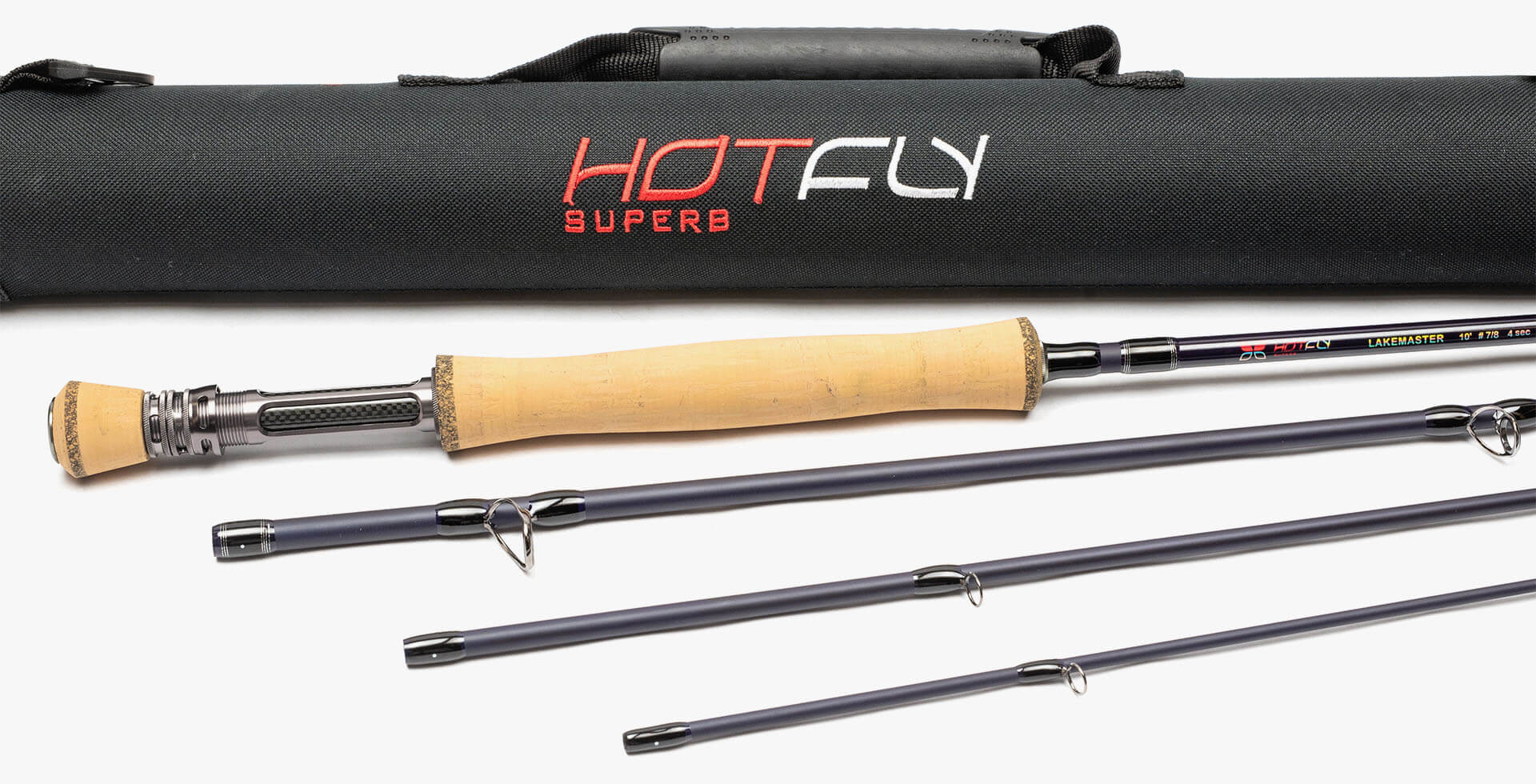
The ideal fly rod is 10 feet long, designed for line classes #7/8 and has a fast, progressive action. With a strong backbone, even the special fly lines can be handled with ease
4. WHAT DO I NEED TO CONSIDER WHEN BUYING A FLY REEL?
As in other areas of fly fishing, the fly reel is not of overriding importance in stillwater. Nevertheless, when buying a fly reel you should make sure that it has sufficient line capacity so that the extra-long fly lines used in fly fishing in stillwater can be accommodated on the reel along with sufficient backing. Nothing is more annoying than a fly line that chafes against the fly reel's cage when reeling in the fish and the reel get stuck because of the poorly laid fly line on the spool. Therefore, the fly reel should have comfortable line capacity.
The reel drag of your fly reel should also work reliably, as you can expect higher average sizes of your fish on stillwater. Especially on larger waters it can happen that a big one gets in, and that is exactly when the drag of your fly reel should work perfectly.
As we will see, both floating fly lines and lines with different sinking speeds are used for fly fishing in still water. Therefore, so-called cassette reels or fly reels with interchangeable spools are worth considering, especially for this fishing technique. This way you have fly lines with different characteristics quickly at hand and, by changing the spool, also quickly ready for use. Since the reel frame always remains the same, you also save a lot of money with such a reel.
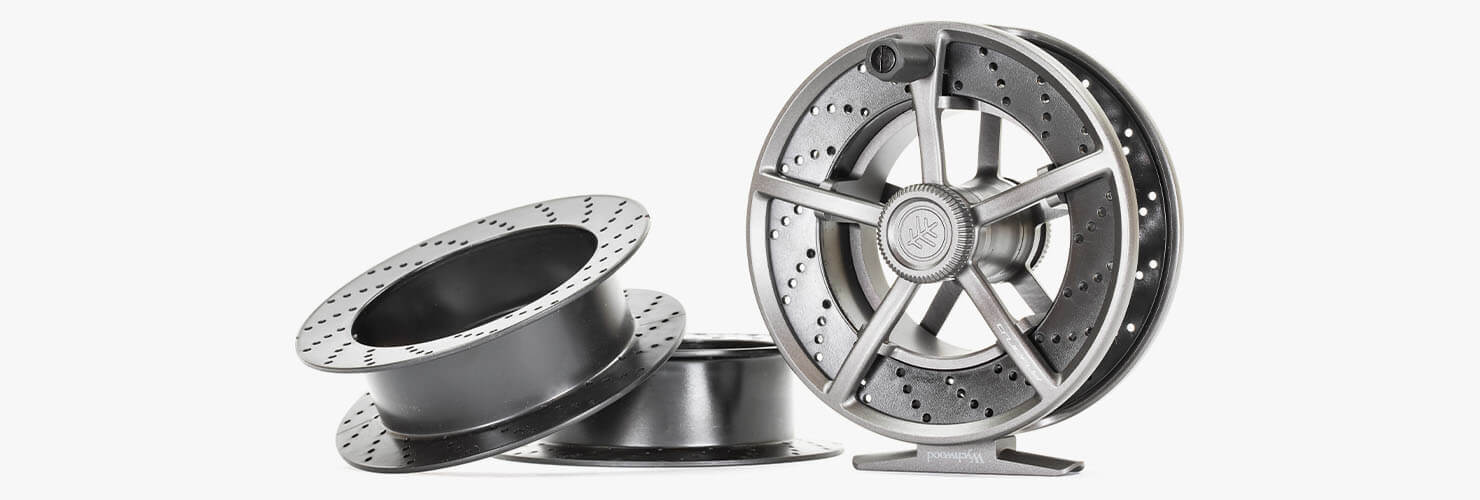
A fly reel with a cassette system makes it easier for you to handle different fly lines
5. WHICH FLY LINES ARE PARTICULARLY SUITABLE FOR FLY FISHING IN LAKES AND PONDS?
Of course, the fly lines used must first and foremost be adapted to the fly rod used so that they work optimally together, and you can cast as far as possible, without overloading the fly rod. In addition, there are some special features that need to be taken into account.
On the one hand, there is the greater distance at which you want to serve your fly. While you usually don't need a casting distance of more than 10 - 15 metres on streams and rivers, it makes a lot of sense to cast much further on standing water because of the larger water surface and thus cover more area. An extra 5 to 10 metres of casting distance can determine whether you have a successful day on the water or go home without catching a fish. And you should reach these distances by default and without too much effort. Therefore, practically only WF fly lines in the slightly higher line classes such as #7 or #8 come into consideration. In most cases you will do well with these. Fly lines designed especially for stillwater fishing usually have a longer belly and front taper, so that the lines are longer overall. And so, you will find lines that can measure 40 metres and more. The longer taper results in a higher line weight and, in combination with the longer casts, the fly rods are also more heavily loaded. Therefore, as already indicated above, the fly rods need a strong backbone and a progressive action that works all the way into the handpiece in order to work optimally with these fly lines and cast far.
With these fly lines it is also important to pay attention to the specific purpose, i.e., the cast. Is the fly line primarily suitable for the classic overhead cast? Or has the fly line and its profile been developed specifically for the Froller or Froll cast, which we will get to know in detail below.
On the other hand, with a long casting distance you only cover one dimension. On stillwaters, however, there is a second dimension, the water depth, which has to be mastered with the right fly lines. Therefore, not only floating lines are used in fly fishing on lakes and fishing ponds, but also intermediates and fly lines with different sinking speeds. This way you cover different water layers effectively and efficiently and bring your fly to where the fish is standing and feeding. Even special stillwater fly patterns as well as different rigs and presentation techniques only develop their full potential in combination with the right fly line. We will go into this in more detail below when we learn about the best fly patterns for Stillwater fishing.
6. ARRIVING AT THE WATER - WHAT IS THE BEST WAY TO START?
The question may seem trivial at first glance, but proper preparation will save you frustration and hassle later on and get you off to the best possible start to your fishing adventure on stillwater. After you have rigged up the fly rod and reel and pulled the fly line through the running guides, pull the fly line off completely and stretch it. Stretching the line makes a lot of sense, especially when fly fishing on stillwater, because it "irons out" any line curls and allows you to cast further. New fly lines often have a coating that makes them feel smooth and a little oily. This coating keeps the surface of the fly line supple in the wrapper and prevents it from becoming brittle. However, especially with intermediate and sinking lines you should remove this coating in order not to negatively influence the sinking properties of your fly line. A polyleader in 10 feet length transmits the casting impulse to the tippet and supports a clean roll-off. We will take a closer look at some standard rigs and fly combinations below. All fly patterns that you want to offer wet, i.e. under the water surface, should be briefly dipped in water beforehand so that the tying material of the fly can soak up water. This way you will present the fly at the right depth from the first cast and the fly will work properly. After you have prepared and assembled everything, you are finally ready to start and make the first cast.
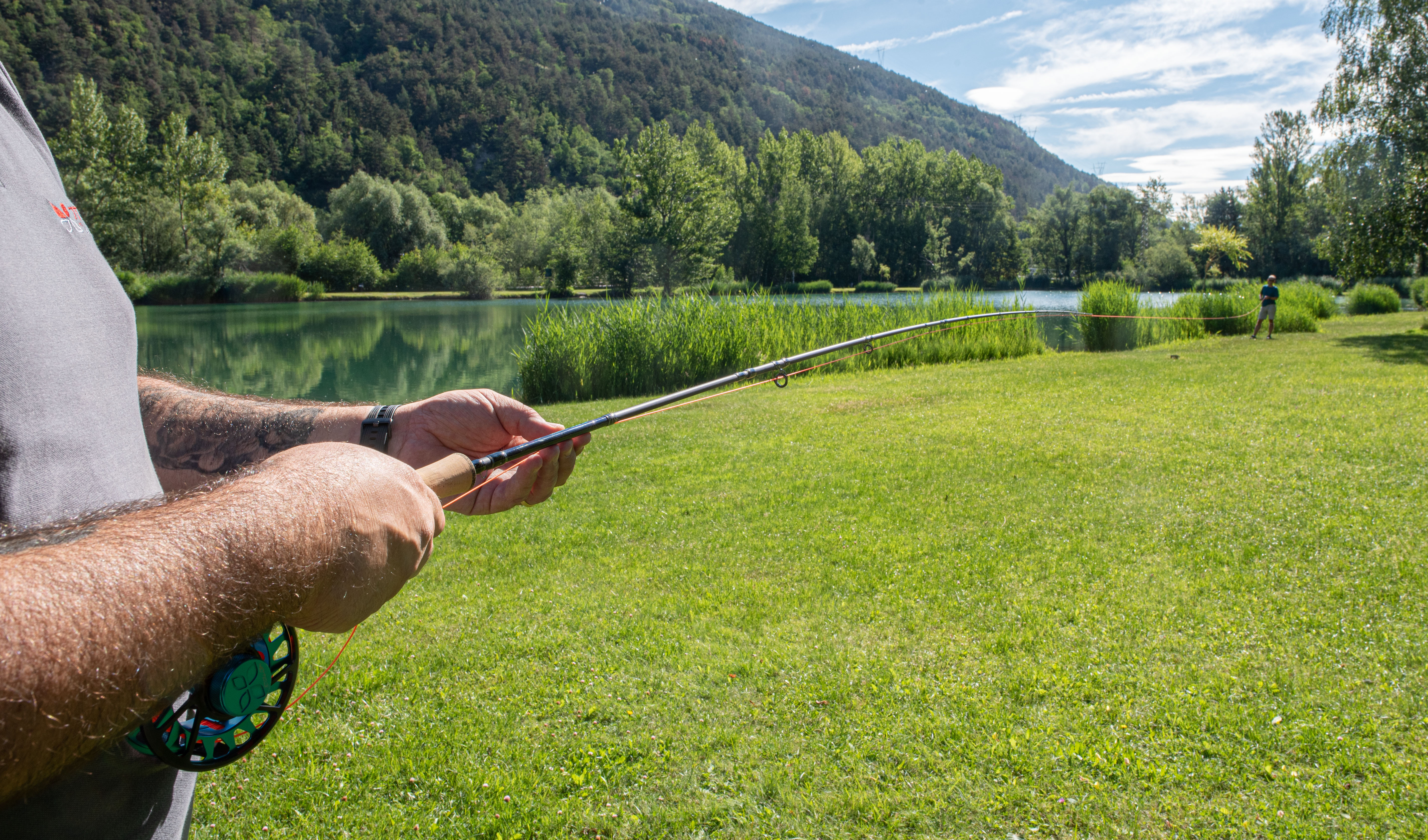
Stretching the fly line counteracts the memory effect and allows longer casts. Of course, this is easier with two people
7. HOW DO I CONSISTENTLY GET MY FLY TO THE RIGHT DISTANCE?
Of course, the classic overhead cast also works when fly fishing inlakes and fishing ponds. But unless you are standing on a long jetty, wading a bit into the water or fishing from a boat, in many situations you simply won't have enough space behind you to make a clean back cast and then let the line shoot.
8. THE FROLLER OR FROLL CAST
At this point we would therefore like to present you a special cast that allows even a beginner without much casting experience to deliver the fly easily at 20 metres and more in a very short time, even if there is not much space in the back. These limited space conditions often occur at groundwater-fed quarry lakes, which often have a steep bank between the upper edge of the terrain and the groundwater level, which offers only little space for the back cast with the classic overhead cast. Since fly-fishing competitions are often held on such types of water, the professional competition fishermen looked for ways to cast the fly further than their competitors in order to gain an advantage. This is how the Froller or Froll cast came into being. Let's take a look at this very effective casting variant, which is based on the roll cast, together in detail and step by step.
The Froll cast makes it possible. With 2 to 3 false casts you can easily reach a distance of 20 to 25 metres - even without much space behind you
CASTING FAR EVEN WITHOUT MUCH SPACE BEHIND YOU
Any spot on the bank where you have at least 1.5 rod lengths of space in the back is suitable for the Froller. More space is not necessary for this casting technique and that is one of the big advantages of this cast. You'll be fine with around 4.5 to 5 metres. Before you start to cast, pull the fly line off the reel so far that the entire line belly lies free next to you. With multi-coloured fly lines you can not only feel the transition from the belly to the running line by the thinning diameter but also by the colour change. With a roll cast you put the first metres of the fly line on the water, stretching the polyleader and the tippet with the flies. Now you have created an ideal starting position to effortlessly serve your fly to 20 metres and more in front of you with a few Froll casts. Like the classic roll cast, the Froller is a water-anchored cast as well, i.e. it makes use of the resistance of the fly line lying on the water. The fundamental difference, however, is that the part of the fly line that you transport in a loop with the forward cast is laid down on the ground next to and behind you during the back cast.
LAYING DOWN THE FLY LINE
Beginning with the rod pointing forward, the rod tip close to the water surface and with a few metres of stretched fly line in the water, bring the fly rod upwards from the horizontal position and let it tilt backwards so that the lifted fly line lies on the ground parallel to the path of the rod tip to the side of you. While doing this, bring the rod hand up over your head and keep the arm slightly bent. The rod hand always remains in front of the body axis so that you do not twist the casting arm and shoulder. The line hand follows the rod hand so that at the end of the backswing both arms are positioned parallel just above and in front of your head. Now a part of the fly line lies next to you on the ground, while the first metres of the line, as well as the Polyleader and the Tippet are still anchored in the water. The fly rod is pointing almost horizontally backwards and has the fly line nicely laid down on the ground.
The aim of this back cast is to lay down a certain amount of fly line next to and behind you in preparation for the next casting step. The length of line laid down also corresponds to the length by which the line is extended forward during the cast. The more line, the further you cast. At the same time, more line also means a larger line loop that forms when casting forward. When casting backwards, the fly rod mainly serves as an extension for your casting arm to be able to lay down enough line. The fly rod is not loaded during this process.
Looking at the dynamics of the entire Froller, the back cast and the forward cast are completely separate from each other. You can also pause briefly between the two movements. Because of these independent movements, this cast is also very fault-tolerant. A backswing that is not quite cleanly executed can be corrected very easily and does not negatively influence the front cast. Therefore, the Froll-cast is very easy to learn and very suitable for beginners.
It is very nice to see how compactly the line is laid down during the backswing. The characteristic "swoosh" can also be heard very well during the forward movement
THE FORWARD MOVEMENT OF THE ROD
Now move the fly rod forward by stretching the rod arm forward so that the rod points in the direction of the cast at shoulder level. The tip of the rod forms a semicircle and lifts the fly line from the ground. It is of course an advantage if the ground is as free as possible from branches, large stones or tall vegetation that could catch the fly line. It is usually sufficient to clean up a few spots that are prone to snagging. In professional competitions, tarpaulins may also be used. However, this is certainly not necessary when you practise it as a hobby. The weight of the fly line also loads the fly rod with the forward movement. The arcing motion is transferred to the fly line, which follows the path of the rod tip and forms a loop, as the line tip cannot slip backwards because it is anchored in the water. By stopping the rod in front of you, the energy of the charged fly rod is transferred to the line in the form of an impulse. This causes the loop to unroll along the entire length of the line, lifting it out of the water and placing it back on the water offset by the length of the line loop. In this way, with only a few empty casts, you can gradually lengthen the special fly line for the Froller until the entire belly is laid out. On many lines the transition from the belly to the running line is colour-coded. With a final Froll-cast you then present the fly to the maximum distance.
HOW TO ENHANCE THE CAST
The more line you have laid down to the side of you, the larger the line loop will be and the further the line will be extended forward during the cast. With a corresponding amount of fly line, you can enhance the casting impulse by an additional pull of the line hand. This ensures higher line speeds and more energy. In this way, the polyleader and tippet also stretch forward to the tip on the final cast. The movement corresponds to the double pull. The difference here is, of course, that only one pull is executed due to the separate back and front cast. To do this, stretch the line hand backwards in a countermovement along your body as the fly rod moves forward.
The cast lives from the dynamics and timing of the sequence, not from the force used. With only 2 to 3 empty casts, you can easily reach 20 metres and more and you are immediately into fishing.
The line arm and rod arm move in parallel. If you want to enhance the casting energy, you stretch the line arm backwards and downwards when moving the rod forwards, so that the fly line is additionally accelerated
Due to the simple and reduced movement, the Froller is also a relaxed cast that does not tire you. Actually, the use of force is rather counterproductive for the success of the cast. This way you can fish for hours in a concentrated and effective manner. A good indication of the correct execution of the cast, with timing and speed that match the line length, is the characteristic "swoosh" sound that the rod and line make as you cast forward. You can also tell a successful Froll-cast by the cleanly unrolling fly line, which also puts down the tippet and fly in a stretched position. A slight jerk in the fly rod at the end of the cast means that the casting impulse was great enough to transport and stretch the entire line rig.
Anyone who has ever held a fly rod and has understood the basic mechanisms of casting can learn this cast in a very short time. With a little more practice, you should easily be able to cast 25 metres and more. And this can be done continuously and relaxed over a longer period of time, with only a few false casts and also in places where there is simply not enough space for the classic overhead cast.
ROD AND FLY LINE MUST BE MATCHED WITH EACH OTHER
A prerequisite for a successful Froll cast, however, is the matching of the fly rod and the fly line used. Once again, we benefit from the constant drive for innovation in the competition scene, so that today we have highly developed and perfectly matched rods and lines at our disposal. A fly rod with a length of around 10 feet offers you a longer lever, making it easier to lift, cast and handle larger amounts of line. The specific fly line for the Froller, on the other hand, has a very special profile with an extended front taper and a long and correspondingly heavy belly, because only the higher weight of the fly line makes the cast work at greater distances. To save you the long search and expensive trying out of different combinations of fly rods and fly lines, we have put together a complete set for you consisting of fly rod, fly reel and matching fly line for froll casting including backing. Everything is perfectly matched, and the fly line and backing are already mounted on the reel, so that this set arrives at your home ready-to-fish.
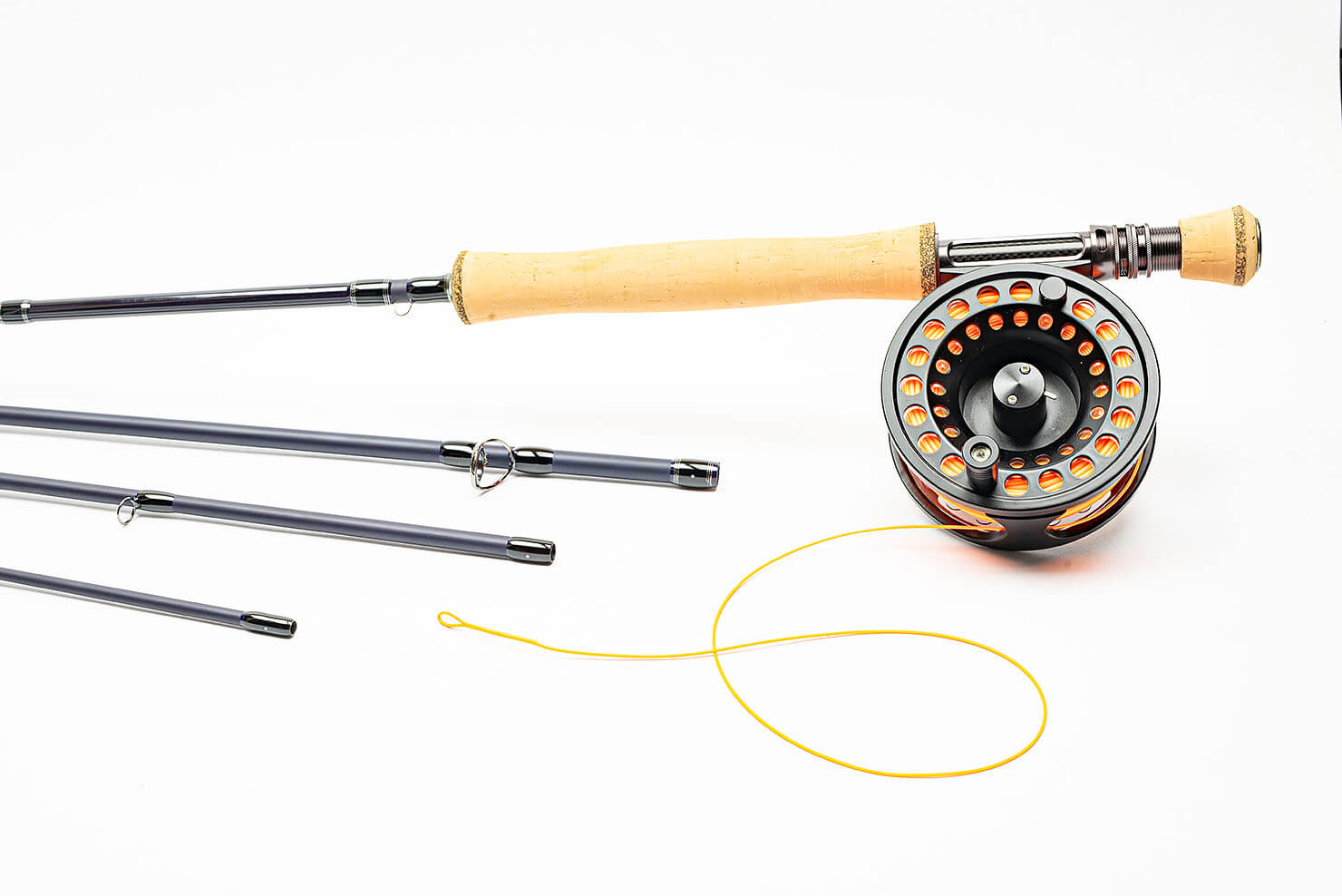
A complete set with fly rod, fly reel, fly line and backing, with all parts perfectly matched to each other
9. SYSTEMATIC FISHING MEANS CATCHING MORE
Fly fishing is a very active and dynamic fishing technique, even on stillwater. Generally, our artificial flies imitate living insects, fish and other prey. Therefore, it is certainly not the most effective tactic to simply cast the fly and wait for the first bite. By breathing life into them through appropriate movement, we increase the appeal of our imitations and are more likely to entice fish to take our flies. To do this, however, we first have to find the fish in the water.
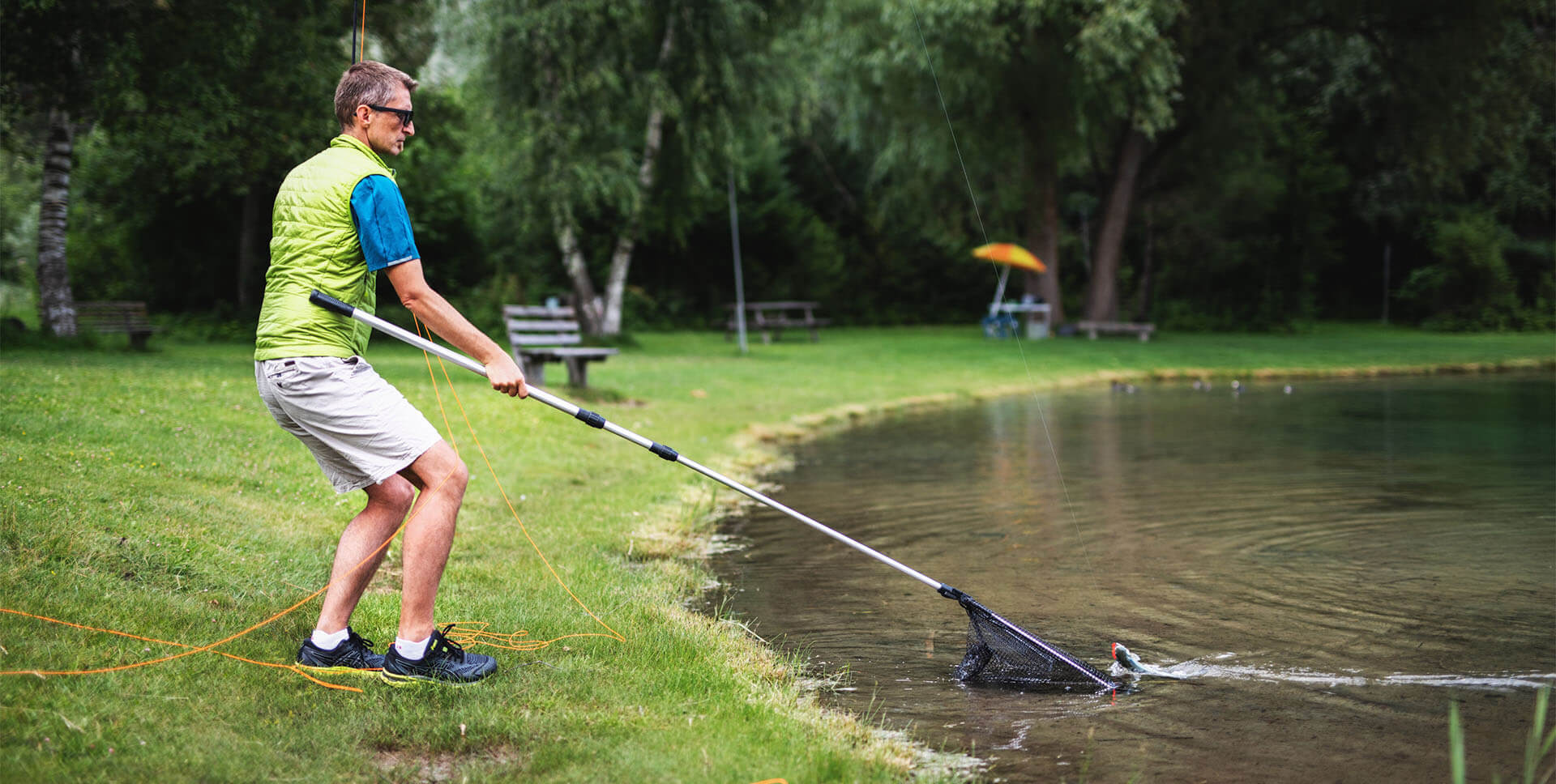
Most of the time, success at the fishing pond is not long in coming
A good clue is the wind direction. The wind creates swell and the resulting current transports the food particles to where the waves meet the shore. The fish follow the food and therefore gather more near this bank. However, tributaries, which in turn also bring in food and are therefore always a fishing hotspot, thermal stratification and other parameters can influence this phenomenon. In addition, at certain times the wind also concentrates very warm or very cold surface water on the shore. Fish then usually look for zones with water temperatures that correspond more to their optimum.
In addition, it is important to bear in mind that it can be exhausting, especially when fly fishing, to cast permanently against the wind. Under such circumstances, the casting distance naturally also suffers. An alternative could be to cast sideways to the wind and fish towards the windy shore.
In lakes and ponds, fish are not only found in different locations, but also at different depths. To find the layer where the active fish are more likely to be, you should offer your fly at different depths. For example, if you spot fry or small fish in the shore area, ideally start your fishing with an intermediate fly line and one or two streamers on a tandem rig that resemble the shape, colour and size of the fish on the shore. Cast and retrieve your flies immediately at or near the surface. Make a few casts, trying to cover the water surface in front of you in a fan shape. If the fish on the surface are not active, repeat the casts, but after casting slowly count to 5 before retrieving. Again, cover the entire area in front of you. In the next round, count to 10, then 15 and so on. If the water is deep and it takes too long for the intermediate line to sink, it can of course make sense to switch to a sinking line. However, the technique remains the same. This way you systematically fish an area of the lake or pond. As soon as you get a bite, you know at which depth those fish are that are also feeding and consequently you will offer your flies preferentially at this depth. If you don't get any bites, you can switch to flashier patterns first to excite the fish more. If you still don't get any bites, change your stand, because it's of little use to keep fishing where no active fish are to be expected. Especially on heavily fished waters, such as fishing ponds, it also makes sense to change your flies more often and try out different patterns. Basically, you should offer your flies as attractive as possible by giving them movement. This way the fish are more likely to pay attention to the imitation. It will also look lively, and you will cover more water surface. But there is an exception to every rule. In very high or very low temperatures, crowded waters, waters where C&R is also practised and other special situations, where the fish are especially suspicious or lethargic, it can also make sense to offer smaller flies such as buzzers and nymphs rather statically in order to entice the leery fish to bite. We'll look in more detail at some of the rigs that allow these offering strategies below.
10. RETRIEVE AND HOOK SET
The way you retrieve the fly line determines the movement and ultimately the attractiveness of your fly to trick and entice the fish to bite. Whether you retrieve the fly quickly or slowly, smoothly or jerkily, must of course first and foremost suit the fly pattern. For example, it makes no sense to pull a popper evenly through the water, because it is the jerky movements that create the characteristic plop. Lures with appendages and tails, on the other hand, need a more continuous movement to work nicely. The speed at which you retrieve the lure will of course affect the depth at which you offer it. The faster you retrieve, the shallower your fly will run.
Even before you start stripping the line, immediately after the cast your line hand should guide the fly line to your rod hand, where you place the line - depending on your personal taste - between your index and/or middle finger as well as the rod handle. This way you can block the fly line on the handle with a minimal movement of your finger when you fell the bite and set the hook, even if you are just reaching around with your line hand.
When you retrieve the fly line, the rod tip should always be submerged in the water by a few centimetres. This way it will move less, there will be no slack line in front of the tip ring, and you will also feel delicate tugs much more reliably and be able to quit them with a strike sooner.
STRIPPING WITH THE LINE HAND
The easiest method to retrieve the fly line is certainly stripping with the line hand. To do this, pass the fly line over the rod hand as explained above and grip it behind the rod hand with the line hand. This method is very variable, because you can do short and long strokes, strip fast or slow and of course also pause. Since you have to keep re-gripping with the line hand at the end of every stroke, the retrieve is jerky and your fly moves through the water in correspondingly small and large moves and jumps. The strike is made with the line hand by making a decisive and long retrieve movement. If the bite occurs at the very moment when the line hand is already stretched back or you are reaching around to make a new move, then block the fly line with one finger on the rod handle, grab the fly line with the line hand just behind the rod hand and set the hook.
HAND TWIST OR FIGURE-8 RETRIEVE
A slow and steady retrieve of the fly is achieved by collect the fly line in loops in the shape of an 8 in your line hand. As you can see in the left video below, you pick up about a hand's width of fly line with each hand movement and accumulate it in your line hand. By varying the hand movement you can vary the speed a bit, but you can't really burn your fly through the water. When the fish get’s your fly, you close the line hand and move it backwards in order to set the hook over the fly line. This is faster and more direct than using the rod. This way you have less dropouts and lose fewer fish.
ROLY POLY
Much faster is the so-called Roly Poly, a very special technique in which you clamp the fly rod under the armpit of the rod arm at the point of the reel after casting. Retrieve then the fly line alternately with both hands. You lay the retrieved fly line on the ground next to you. Since you can use both hands and reel in a length of line from the guide ring of the rod to the handle with each movement, you will naturally strip a lot of line very quickly in this way. But you can vary the movement very well, make long and short strokes and also pause. Since with this special retrieving method the line cannot be blocked with the fingers on the rod handle, it is all the more important to hold the taut fly line securely with at least one hand at all times so that you set the hook in every moment. As you can see in the first video below, the hook is set by tightening the fly line. After the strike, immediately pick up the rod and play the fish as usual.
11. WHICH FLY PATTERNS CATCH IN STILLWATER?
NATURAL PATTERNS
Of course, you can also catch fish in lakes and ponds with your usual fly patterns, because fish in these waters also feed mainly on insects, small fish and other prey. Therefore, your dry flies, wet flies, nymphs and streamers are also used in lakes and ponds and bring you the fish. However, while in streams and rivers the continuous current gives life to your artificial flies by moving the imitations and letting the legs, antennae and other appendages play seductively in the water, in stillwater your artificial flies only come to life through your movements when retrieving them. This category of natural imitations can be extended in stillwater by the group of so-called buzzers, which imitate the larvae of twitch flies and resemble nymphs.
In addition to the various realistic fly patterns, there is also a whole range of special artificial flies used in stillwater fly fishing, which are very conspicuous both visually and in terms of movement, but have proven to be extremely catchable, especially on commercial fishing lakes, primarily for trout. As we have seen for tackle and technique, the development of the patterns as well as the tying materials used is primarily driven by the competitive pressure of the competition scene. These sometimes shrill fly patterns appeal to fish via various sensory stimuli and are therefore more likely to be noticed in waters with high fishing pressure and correspondingly suspicious and sometimes lethargic fish. In addition to the bright, contrasting colours, these flies should therefore also have as much movement and vibration as possible to arouse the fish's curiosity and ultimately tempt them to bite. Here we briefly introduce you to boobies, blobs, fabs, egg imitations and special stillwater streamers and explain when and how you can best use them for fly fishing in stillwater.
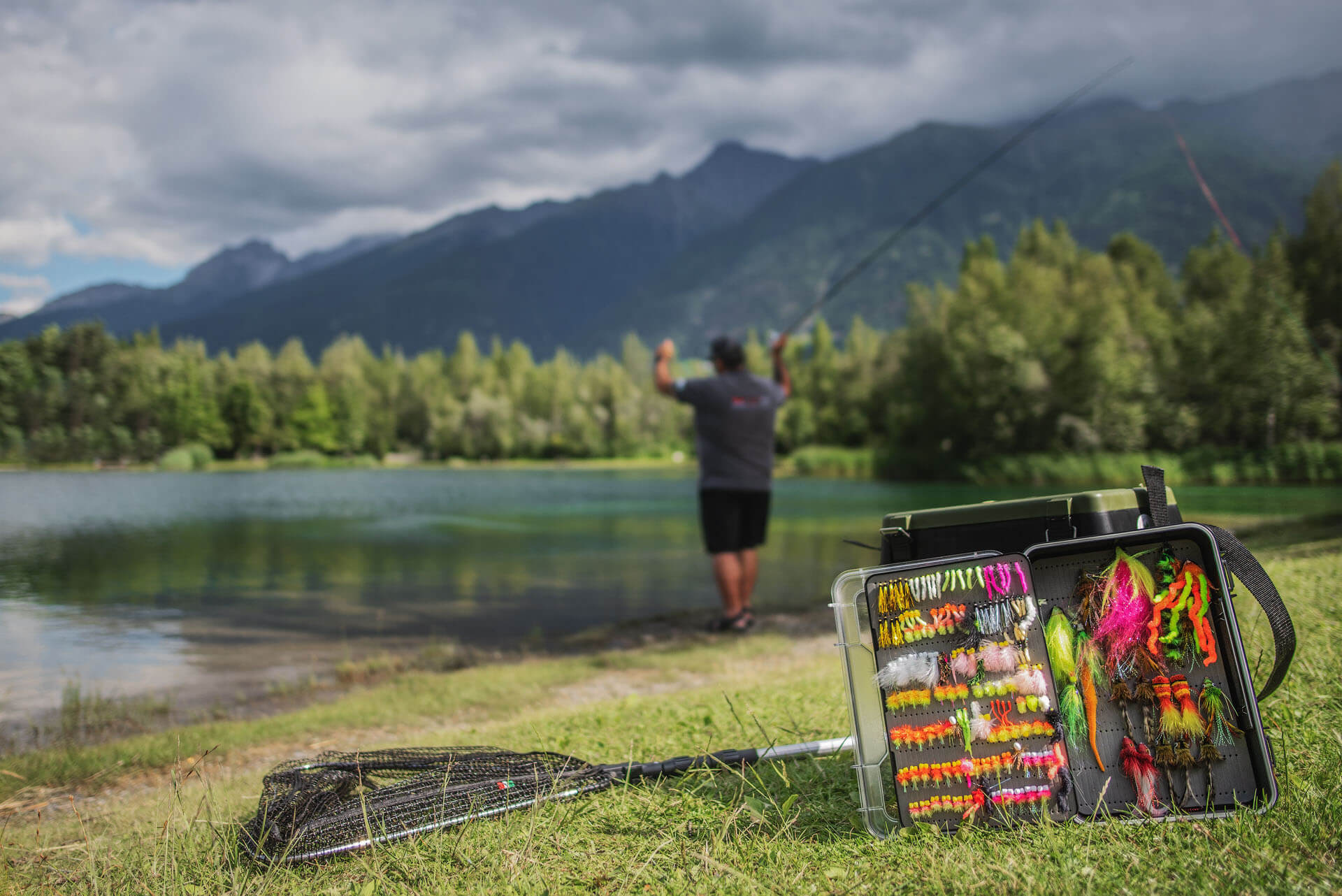
The typical fly box of a stillwater fly fisherman
BOOBIES
Boobies are the name given to all those fly patterns that have a buoyancy body - usually made of foam - tied in behind the hook eye, which looks like an oversized pair of eyes. The body, on the other hand, can be bushy or slender, compact or elongated. Boobies are part of the standard repertoire of a stillwater fly fisherman and should not be missing from your fly box. Apart from their visual appeal, it is their very characteristic movement that makes boobies so extremely catchy. The "eyes" of the boobies cause a water resistance when retrieving and provide agitation due to the small bow wave. In addition, this resistance induces a wiggling movement of the booby, so that the attached appendages and tails glide quite seductively through the water. Boobies are offered as standard on a floating line because of their floating properties. Here, the booby is normally attached as a tip fly. Smaller patterns on one or more side arms will increase your chances of catching. Below we present some standard rigs in more detail. Another ingenious variation is to offer the floating boobies on a sinking line. This allows boobies to be offered at any desired depth. When the fly line is retrieved, the boobies move downwards towards the sinking fly line, and during the retrieve pause, the booby slowly rises again due to its own buoyancy. By using fly lines with different sink rates and combining them with different tippet lengths, fly sizes and retrieve speeds, as well as making variable stops and pauses when retrieving, you can offer your Boobies in an extremely varied and therefore extremely attractive way in different water depths.
BLOBS
Blobs are a group of quite compact, bushy and voluminous flies that are very popular as stimulus flies. They are fished unweighted as well as with a small head bead that lets them sink slowly. Blobs can be fished and offered in an incredibly variable way. In combination with other, more natural fly patterns, fished on the uppermost side arm, they mainly attract attention due to their bright colours. Either the fish takes the blob directly or turns to a small buzzer or nymph, which is offered on the additional side arm. On a rig combined with a streamer on the tip, the blob often causes feeding envy so that the fish pounce on the blob or attack the streamer directly. Fished lightly weighted as a tip fly, on the other hand, the blob provides a slow, steady and natural sinking of buzzers and nymphs, which are readily taken by roaming fish. Blobs are very catchy due to their versatility in very different situations and are also easy to handle. Therefore, they are a very grateful fly pattern especially for beginners, with which the first successes on still water are not long in coming.
FABS
FAB is the abbreviation for Foam Arsed Blob and as the name suggests, this group of artificial flies is a variation of the blob in which a buoyancy body made of foam is tied into the rear part of the fly. Offered on the floating line, FABs as a top fly can be offered together with buzzers or nymphs on side arms just below the water surface and thus exactly where the emergers of the twitch flies pause briefly when rising to hatch. And here they are readily eaten by fish in large quantities. Tied on the first side arm behind the floating line, the FAB acts as a bite indicator and the flies mounted behind it sink slowly and evenly. As soon as you start stripping, they move back towards the surface to slowly sink again during the retrieve pause. Due to the buoyancy body, however, they can also be offered on sinking lines in a similar way to the boobies. As soon as the line has sunk to the desired depth and you start retrieving, the FAB is pulled down and slowly rises towards the surface again during the retrieve pauses.
FISH EGGS AND BAIT PASTE
Fish Eggs and Bait Paste are fly patterns that can produce very good results, especially on commercial fishing lakes with high fishing pressure. In these waters, fish are used to the fishing paste utilized by many anglers and are literally fed with it when it accidentally falls off the hook during casting. The development of innovative fly-tying materials has made it possible to imitate not only the colour and appearance of this fishing paste, but also its gelatinous consistency. The Eggstasy Chenille material absorbs a lot of water, becomes slightly translucent and has a texture similar to natural fish eggs or fishing paste, so that the fish do not become suspicious when they take the fly and do not immediately spit out the supposedly tasty morsel. These very special fly patterns can be offered very well on their own as lace flies. In combination with fly lines of different sink rates you can offer fish eggs & paste in different water layers. In tandem with a streamer, you will arouse food envy in many fish so that they will take the fly even though they are not actively foraging. It can also happen, that the supposed food competitor is attacked immediately.
STREAMER
Streamers perfectly imitate small fish, fry and other prey and are therefore not a specific fly pattern for stillwater fly fishing but are also successfully fished on running water. Due to some differences between still and flowing waters, your streamers should have some specific characteristics for use in lakes and ponds. A streamer is most attractive when it glides through the water as lifelike as possible and plays seductively. In flowing waters, it starts to work immediately due to the continuous current. In lakes and ponds, instead, this current is missing and so the play and thus the attraction of the streamer depends very much on the fly-tying materials used, in order to give the streamer a lively play already in the passive sinking phase. Too much weighting would be counterproductive, so you should go for streamers that are weighted cautiously and have a lot of movement of their own, so that they pulsate nicely when retrieved in a variety of ways with strips and stops.
12. WHICH RIGS FOR FLY FISHING IN STILLWATER?
We have already briefly mentioned suggestions for successful rigs and presentation for Stillwater fly fishing within the single groups of special stillwater flies. Of course, a successful rig is up on many things. First and foremost, it depends on the water being fished, the target fish and their activity, but also on the fly or fly combination you have chosen and, last but not least, on your personal preferences, because you have to be able to cope with the rig on the water in order to present the flies in the best possible way. Nevertheless, we would like to introduce you to three common rigging variations for different fly combos, which you can then adapt to the current conditions on your water.
FLOATING "WASHING LINE"
Beginners usually get on best with a floating fly line when fly fishing in lakes and ponds. It is easy to handle and control, both when casting and retrieving. Therefore, the rig we are going to show you is based on a floating line, which you ideally equip with a 10 foot (305 cm) long, transparent polyleader. Modern fly lines and polyleaders can be connected quickly and easily using the factory-made loops. The polyleader forms a nicely graduated transition to the tippet and transmits the casting impulse more evenly, so that the entire rig rolls off better all the way to the tip. Loop a 230 cm long monofilament nylon tippet with a line diameter of 0.20 mm through the front end of the polyleader and attach two side arms with the same line diameter at a distance of 70 cm from the loop and from each other. These should not be too short and may be 12 cm long, so that they stick out nicely and the flies attached to them can move neatly. You can enhance the movment by attaching the flies not with a fixed knot but with a small loop knot, such as a perfection loop. In addition, sidearms of a certain length allow for several fly changes. Suitable flies to be attached to the two side arms are small, light nymphs or buzzers. A booby is tied to the rear tip of the tippet. Due to the floating line and the booby, this assembly floats on the surface and resembles a washing line, on which in this case no clothes are hanging but artifical flies on the 2 side arms. That's where the name of this rig comes from.
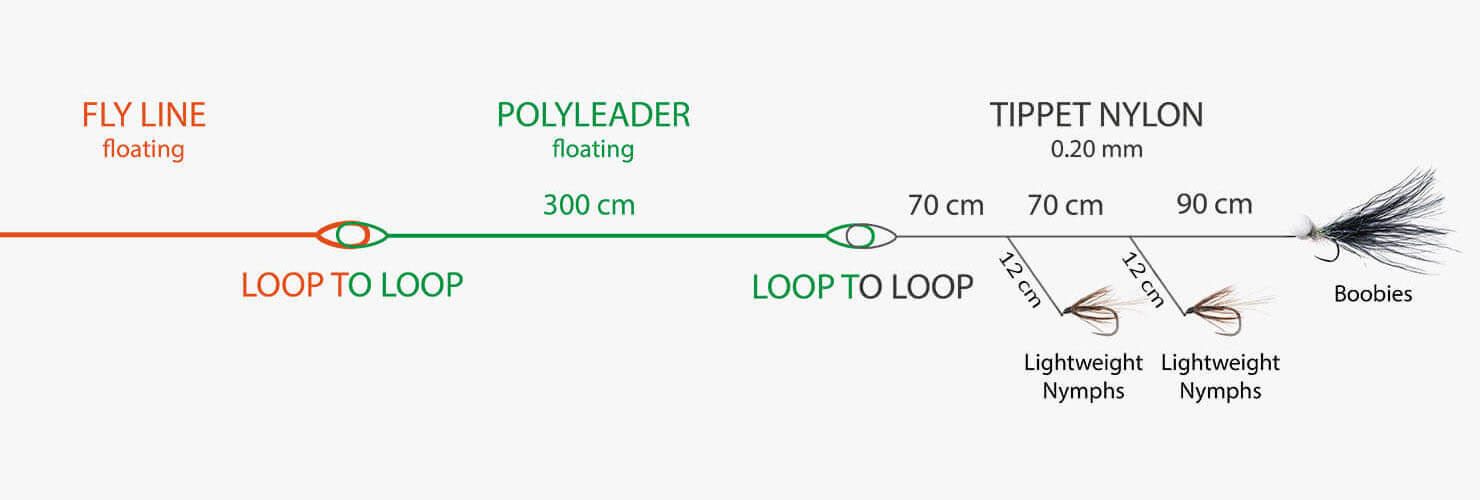
The floating "washing line" is simple to set up and easy to fish. The flies can be presented statically or by slowly retrieve
The two flies on the side arm float just below the water surface and are moved slowly and rhythmically up and down slightly by the swell as well as the slow retrieve of the fly line. The booby acts as a float, bite indicator and lure fly, but is also often taken itself if you let it dance nicely on the surface while retrieving.
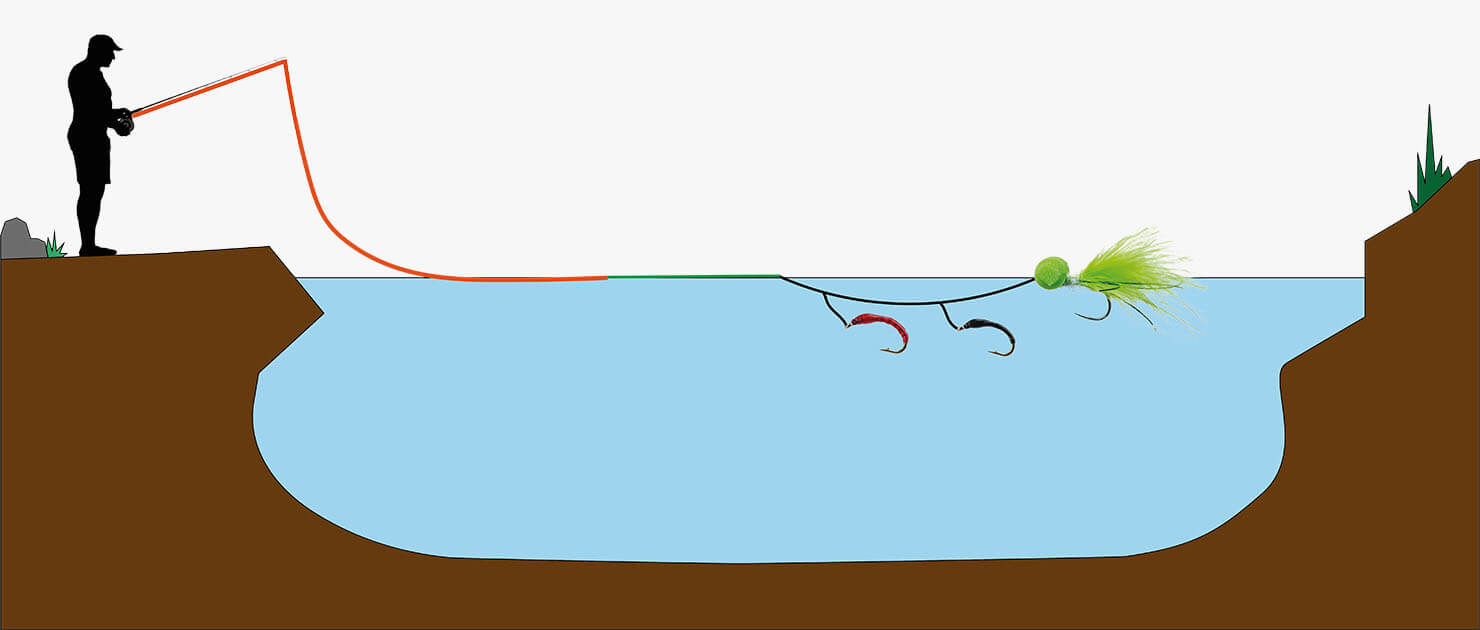
With the floating "wahing line" you can offer several natural patterns like buzzers or nymphs just below the water surface
SINKING "WASHING LINE"
The sinking version of this rig is very similar. Instead of the floating line you choose an intermediate or a sinking line - depending on the depth of the water - and combine it with an appropriate polyleader. The sink rate of the fly line should be equal to or higher than the sink rate of the polyleader, so that a nice line bulge is formed in the water, with the sinking line forming the lowest point. The tippet is build up identically to the floating washing line and the individual lengths and distances are also the same. A booby (or alternatively a FAB) is attached at the rear end. The difference to the previous variant is that the flies on the side arms can be somewhat larger, more conspicuous and possibly also a little weighted. For example, you can attach a blob or a fish egg on one side arm and a nymph, a buzzer or wet fly on the other side arm.
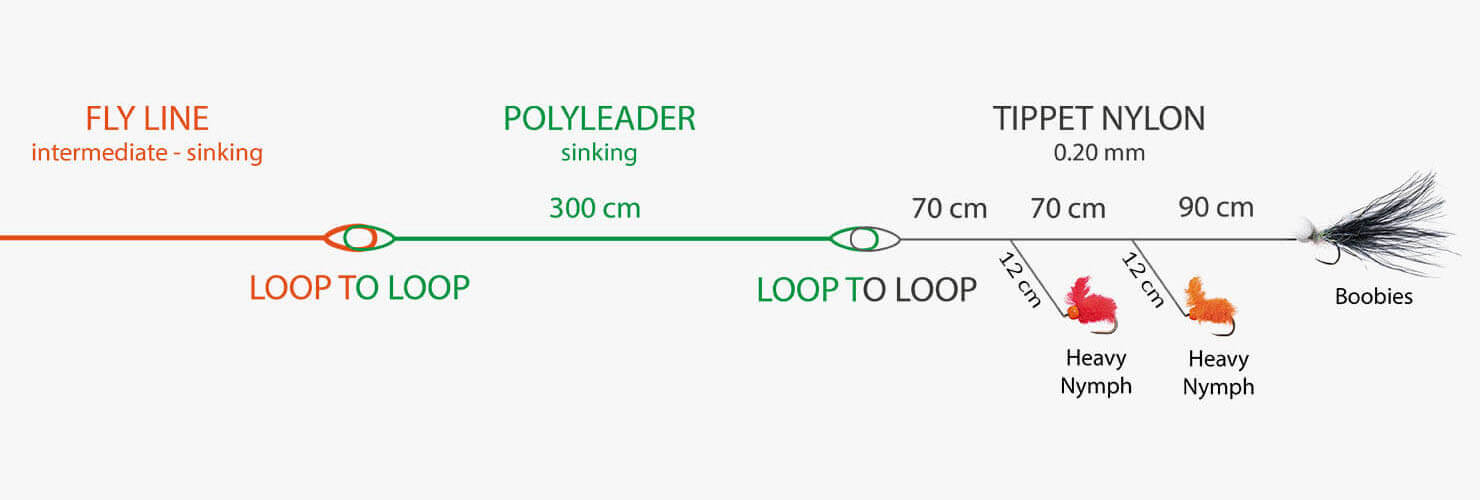
The sinking "washing line" is similar to the floatant version, haveing the same lenghts and distances. The fly line should sink at an equal or higher rate than the polyleader
After casting, the sinking fly line brings the rig to depth, but the buoyancy body of the booby lets the rig sink more slowly than the fly line. When the fly line has reached the desired depth, you can retrieve it. This pulls the booby and thus the rig further down towards the level of the sinking line. In the pause, the booby again slowly rises towards the water surface and takes the rig along with the two flies on the side arm. In this way you work a whole depth range very efficiently.
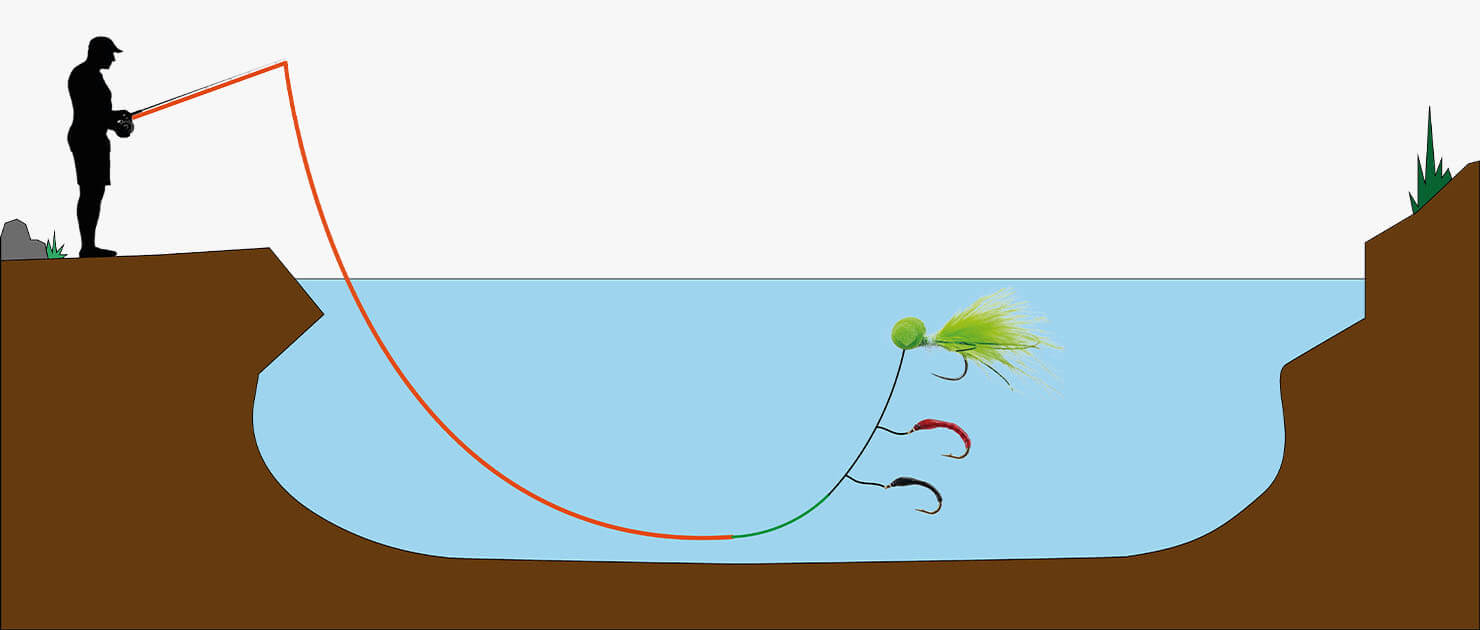
The booby drifts towards the water surface during the retrieve pauses and provides a bobbing movement of the tippet and the flies on the side arm
TANDEM RIG
The tandem rig is best combined with two streamers, the front one usually being the smaller one, while the rear one imitates the supposed small predator chasing the prey fish in front of it. You can serve this rig on floating line, intermediate or a sinking line depending on the water conditions and the activity of the fish. Here, too, a polyleader helps you to cast the whole rig cleanly even with the streamers that can have a little more air drag. To ensure the most direct connection possible, the floating or sinking characteristics of the fly line and the polyleader should be matched. The tippet can be chosen a little shorter here at around 160 cm, as only two flies are being attached. The shorter tippet also prevents the streamers from being retrieved in a different water layer than the fly line when used on a sinking fly line. The distance between the two flies and the polyleader should be even. The recommended diameter of the tippet of 0.20 mm is a guideline. Depending on the fish species, it should of course be adjusted, as the streamers tend to attract larger fish. You can be very variable when retrieving the rig. Whether you let your fish swim through the water in short or longer jerky escapes, or retrieve the line in Roly-Poly style at high speed, depends on the fish species and their current activity.
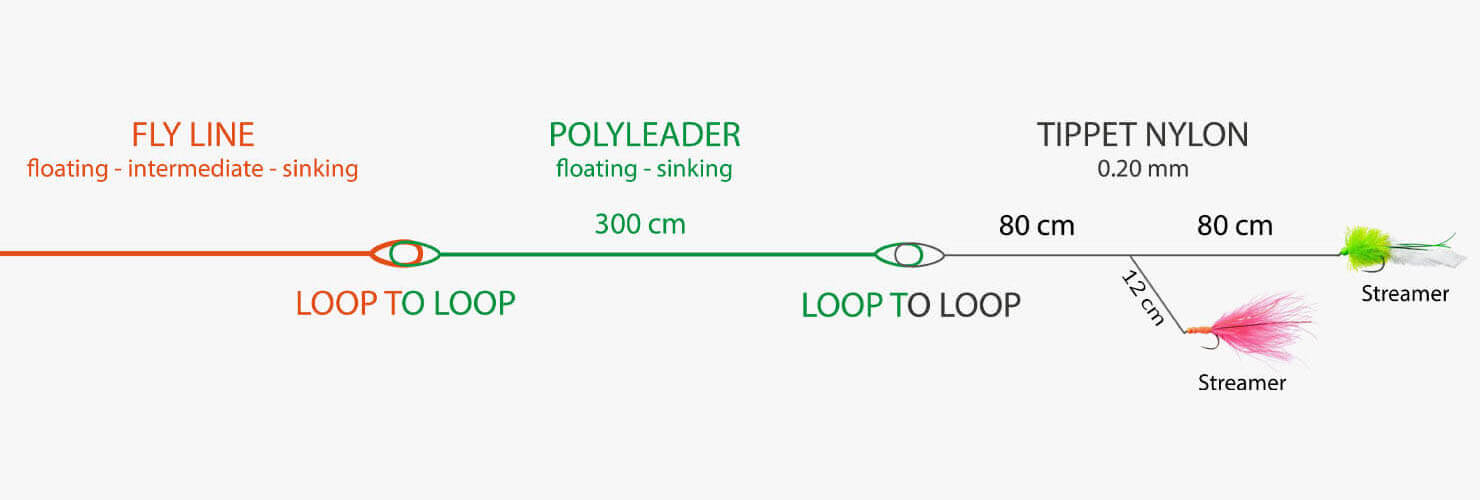
Offering more than one fly increases your chances of catching fish, also with streamers
Whatever rig, fly and presentation you choose, we recommend fishing with more than one fly. This increases your chances of catching fish enormously. The rigs presented here as well as the lengths and diameters given are only guidelines. Just try it out and adjust all the variables so that you get along well on your water and with your flies, have fun fishing and optimise your catching success.


